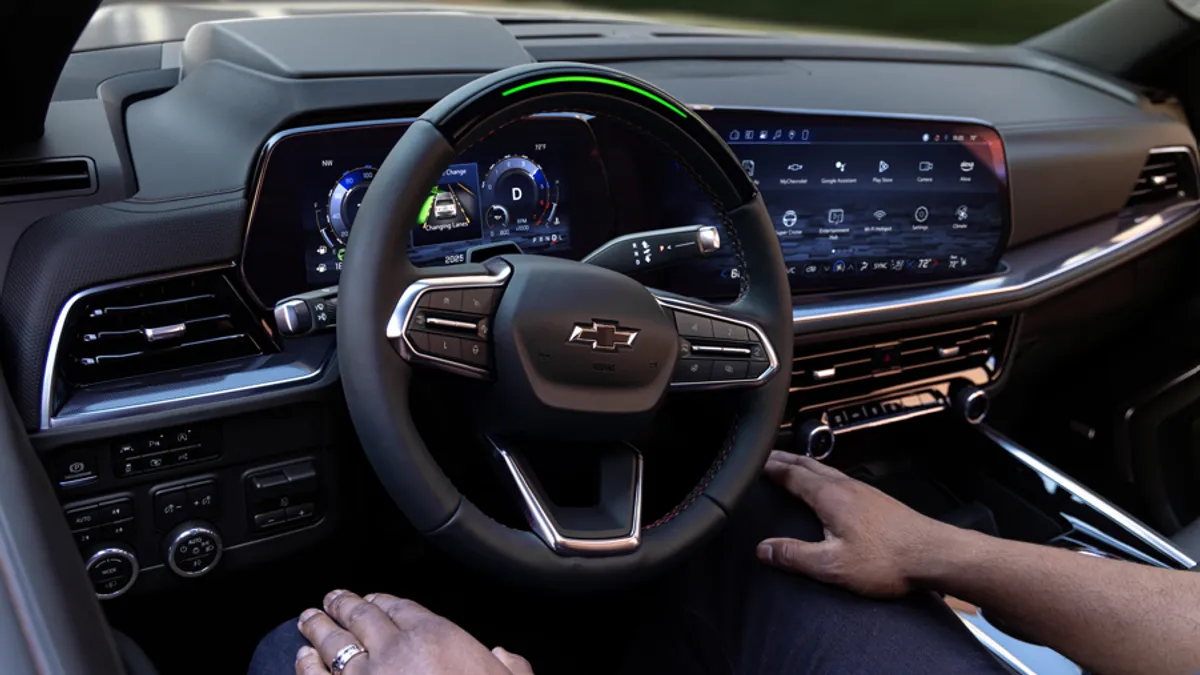Automakers say the National Highway Traffic Safety Administration’s proposal to require vehicle manufacturers to install seat belt use warnings for right-front and rear passengers could cause an uproar among drivers, according to public comments submitted to the National Highway Traffic Safety Administration.
The Alliance for Automotive Innovation, an industry group, said the proposed rule includes several provisions that would annoy or confuse drivers and passengers.
Those provisions include NHTSA’s proposal to require automakers to provide audio-visual seat belt warnings for the driver and right-front passenger seat upon startup. The rule would also mandate those reminders remain active until both occupants fasten their seat belts.
Under the current rule, which only applies to the driver’s seat, automakers must provide an audible warning lasting at least four seconds and a visual warning lasting at least 60 seconds. Automakers, however, have voluntarily provided warnings for both front seats in nearly all passenger vehicles in the U.S. as of model year 2022.
Auto Innovators said the existing warnings already cause customer complaints and that NHTSA’s proposal would likely exacerbate them without providing a safety benefit.
“Requiring that the driver or passenger seated in parked vehicle be subjected to an indefinite
audible warning until the belt is buckled will create significant annoyance,” Auto Innovators said. Customers often complain that the seat belt warnings do not give them time “to get situated or even put the belt on,” which can make the reminders “aggressive and annoying.”
Auto Innovators recommended NHTSA require a visual warning at startup, with an audible warning kicking in once the vehicle travels 500 meters, reaches 25 km/h (15.5 mph) or one of the affected seat belts remains unbuckled for more than 60 seconds.
The National Safety Council, however, supported NHTSA’s audio-visual warning recommendations for right-front seats.
The safety group said long, loud, audible warnings are most effective for getting people to wear seat belts, citing a 2019 study by the Insurance Institute for Highway Safety that found audible warnings lasting at least 90 seconds increased seat belt use by 30%-34%, with indefinite warnings performing best. The study found audible warnings lasting 90 seconds or more could save nearly 1,500 lives in the U.S. each year.
NHTSA proposed allowing automakers to comply with its rear seat belt reminder mandate using one of three options for the visual warning on vehicle startup: positive-only, negative-only and full-status.
A positive-only system would inform drivers how many or which rear seat belts were buckled, which would be the least expensive option since it would only require a belt latch sensor.
A negative-only system, meanwhile, would tell drivers how many or which rear seat belts are not in use, while a full-status system would provide information about how many or which seat belts are in use or not in use.
NSC said it only supported the negative-only and full-status options, which, according to NHTSA, would require automakers to install occupant detection systems and belt latch sensors.
The safety group wants NHTSA to require automakers to install rear-seat occupant detection systems, which the agency nixed over concerns related to child seats and transporting objects like packages or pets. NSC said automakers could potentially circumvent those difficulties by installing “low cost 2-D or digital cameras” instead of in-seat sensors to detect rear seat occupants.
“The cost will decrease even further if rear seat belt occupant detection systems are required in all vehicles,” NSC said.
Auto Innovators, however, said NHTSA should allow the positive-only option and permit automakers to provide drivers with information about which rear seat belts are buckled, regardless of whether they’re occupied.
In its proposed rule, NHTSA said it would not “allow a warning for an unfastened seat belt at an unoccupied seat … because we tentatively believe that the resulting ‘false’ warning would potentially annoy drivers and lead to behaviors that would decrease system effectiveness.”
IIHS’ rear seat belt reminder assessment and the Economic Commission for Europe of the United Nations rules allow such warnings.
Auto Innovators said NHTSA’s approach was misguided, suggesting the requirement was tantamount to an occupancy detection mandate.
“There is no additional safety benefit by requiring an occupant detection system to a rear seat belt reminder system that already provides information for every seating position, as is the case with the ‘negative-only’ systems,” the industry group said. “Auto Innovators is not aware of any data that would support NHTSA’s claim that a visual indication of an unfastened seat belt at an unoccupied seat would annoy drivers.”
Auto Innovators wants NHTSA to allow automakers to comply with the visual warning requirement for rear seats without requiring occupancy detection for positive- or negative-only systems.
“If the main concern with this approach is driver annoyance, NHTSA should consider allowing a dismissible initial warning, as is the case with both IIHS and [regulations in Europe],” the industry group said.
But NSC said occupancy detection systems are necessary if NHTSA wants to improve safety.
“The only way to require audible warnings, which greatly increase system effectiveness, would be to also require occupant detection systems,” the safety group said.




















